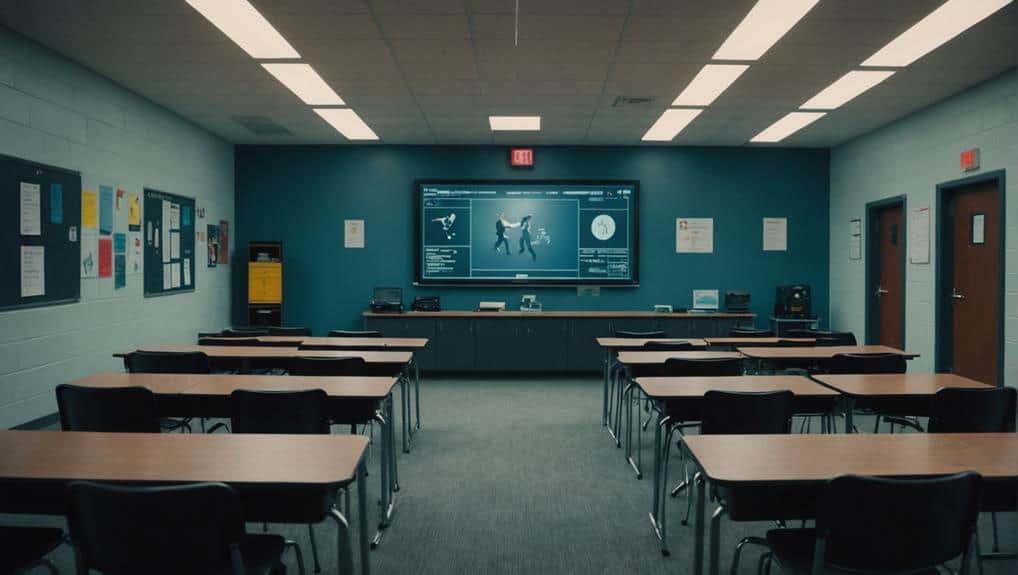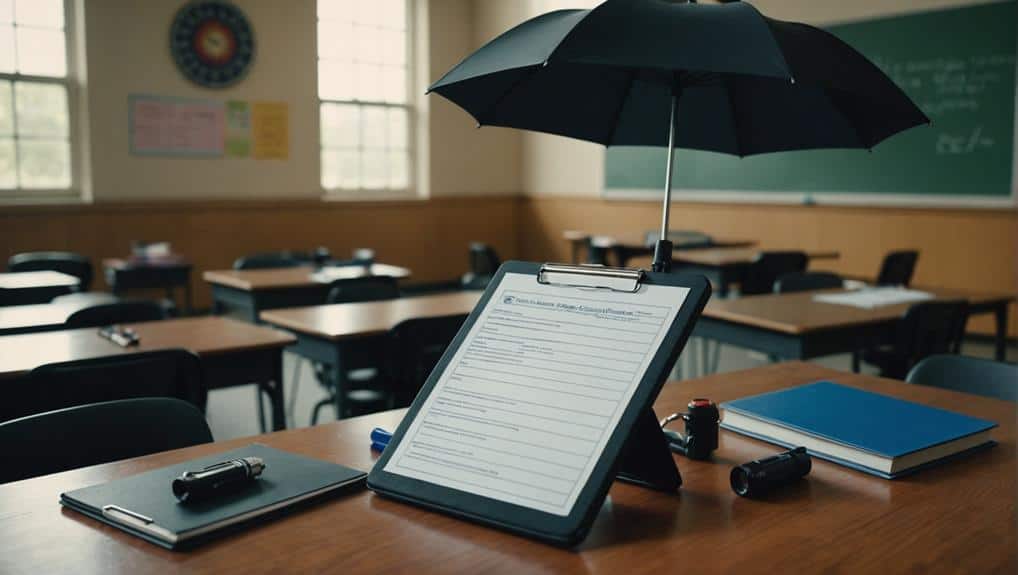Imagine you’re in a classroom, and a sudden threat appears – knowing how to turn
everyday objects into lifesavers is revolutionary. You can use duct tape to
secure doors, stack desks like a pro, and even have a fire extinguisher ready to spray and disorient an intruder. It’s not just about the hardware; it’s about
mental prep too.
Regular drills and role-playing with colleagues create muscle memory, so in high-stress moments, you act swiftly without overthinking. Kinda like a secret agent, right? And trust me, there’s a whole lot more to making your classroom a fortress, just keep diving in!
Context of School Safety
Although schools are meant to be
safe havens for learning, the reality of potential threats like
active shooter incidents can’t be ignored. You might think your school is immune, but the average duration of these horrifying events ranges from just 3 to 15 minutes. That’s barely enough time to react, making
personal safety a top priority.
Imagine being responsible for 850 potential victims in your school. It’s a
staggering thought, right? Historical occurrences of school shootings have turned the idea of an
armed intruder from an unlikely scenario to a terrifying possibility. This is why it’s vital for educators like you to be mentally prepared for
high-stress situations. You need to know how to fight back if necessary.
Now, let’s be real—schools are supposed to be
weapons-free zones. But some argue they’re actually “victim zones” because there’s no way to defend yourself. It’s frustrating to think about, but self-reliance and
proactive defense strategies are essential. Of course, you have to weigh the potential consequences of defensive actions, like job loss, but isn’t your safety—and that of your students—worth it? Balancing these risks and planning carefully can make all the difference.
Evacuation and Barricading
When facing a threat, your first move should always be to find a
safe way out, but if that’s not an option,
barricading the door can buy you precious time. Imagine quickly stacking desks and chairs against the door, using wooden wedges, duct tape, or paracord to make it nearly impossible for an intruder to get in. And don’t forget to think outside the box—literally! Climbing into ceiling spaces or up lockers might just be the
unexpected escape route that keeps everyone safe.
Strategic Escape Routes
One of the most essential steps in ensuring classroom safety is having well-defined
strategic escape routes. When faced with a threat, your first response should be to
exit the building or area as quickly as possible. Imagine a scenario where you’re teaching, and suddenly, you hear commotion—don’t hesitate. Think of your escape route like a martial artist’s move,
swift and decisive, not like Jailhouse Shanks, which is slow and risky.
Before anything happens,
check its charge—your escape route, that is. Make sure it’s
free from obstructions and that everyone knows the plan. You don’t want to be fumbling around when every second counts.
In some cases, you might not have the option to flee. That’s where
barricading comes in.
Heavy furniture, like desks and bookshelves, can be your best friends. Rearrange them to block the door, creating a fortified barrier that makes it tough for an intruder to get through.
If escape or barricading isn’t possible, consider using ceiling spaces to hide. It’s not just about staying out of sight; it’s about
buying time until help arrives. Your safety toolbox should also include paracord or duct tape to enhance door security.
Effective Door Barricades
Barricading classroom doors effectively can make a world of difference during a crisis. You need to be prepared to act quickly, and knowing the right barricade materials and techniques can save lives. Here’s how you can make your classroom safer:
- Heavy Furniture and Wooden Wedges: Pushing desks, tables, and chairs against the door can create a strong barrier. Wooden wedges under the door can also delay intruders, giving you more time to react.
- Paracord and Duct Tape: Securing the door with paracord and duct tape adds another layer of resistance. This method has shown great results in emergency drills, making it harder for anyone to force their way in.
- Steel Bars for Reinforcement: Reinforcing doors with steel bars can transform them into hardened barriers, offering significant protection. This added strength can make your classroom a fortress against threats.
- Regular Classroom Drills: Practicing these techniques through regular drills guarantees that everyone knows what to do when the time comes. Familiarity with the procedures can make all the difference in a high-stress situation.
Improvised Defense Tools
In a classroom setting, everyday items can become powerful
improvised defense tools, giving educators a crucial edge during emergencies. With some
quick thinking and adaptive strategies, you can turn ordinary objects into lifesavers. Imagine grabbing a golf club from the sports equipment rack. It’s not just for your golf unit anymore; it can be a solid
self-defense weapon. Or perhaps you spot a small ball peen hammer in the art supplies—now it’s a
versatile tool for protection.
Hand sanitizer isn’t just for keeping germs at bay. In a pinch, it can
temporarily blind an attacker, giving you those precious seconds to act. And don’t underestimate the fire extinguisher. Besides putting out fires, it can spray an intruder or become a hefty striking tool.
Then there’s the trusty duct tape. It’s been proven in experiments to secure doors effectively, making it a
barricading hero during a threat. And if you’ve got a hollowed-out book, you’ve got the perfect
secret stash for self-defense items, always within arm’s reach yet hidden from plain sight. So, with a bit of creativity and a lot of resourcefulness, your classroom can be a
surprisingly secure space.
Creative Defense Techniques
Frequently, the success of classroom defense hinges not just on having tools but on knowing how to use them creatively. Imagine, for example, turning everyday items into lifesavers. You might not think of a golf club or a fire extinguisher as a weapon, but in a pinch, they can be incredibly effective.
To help you get started, here are four creative defense techniques:
- Role Playing Drills: Practice scenarios where you and your students use items like flashlights or hand sanitizer as defensive tools. This builds muscle memory and keeps everyone alert.
- Classroom Layouts: Strategically arrange furniture to create natural barricades. Heavy desks and wooden wedges can slow down intruders, giving you precious time to act.
- Emergency Communication: Establish a system for quick and clear communication during emergencies. This could be a series of code words or signals that everyone understands.
- Improvised Traps: Use paracord and duct tape to set up makeshift traps on door knobs. These can surprise an intruder, giving you a tactical advantage.
Practical Self-Defense Tips
When facing a threat, your first move should always be to get out as quickly as possible, but if that’s not an option, you can use
heavy furniture to block the door and buy some precious minutes. Think creatively—grab a golf club or fire extinguisher as an
improvised weapon, and practice using these items so you’re ready if the worst happens. Even something as simple as duct tape and wooden wedges can turn a regular door into a
strong barricade, giving you and your students a better chance to stay safe.
Improvised Classroom Defense Tools
Facing an emergency in the classroom can be intimidating, but you can turn everyday items into effective self-defense tools with a bit of ingenuity. Understanding self defense psychology, classroom preparedness, and threat assessment is essential for staying calm and acting swiftly. Here are four practical tips to get you started:
- Golf Clubs and Small Hammers: These can be fantastic improvised weapons. A golf club can keep a threat at a distance, while a hammer provides close-range defense. Keep them accessible but out of plain sight.
- Securing Doors: Use paracord, duct tape, or a Door Stop Alarm to secure doors. This can delay intruders, buying precious time for evacuation or other defensive actions. Just imagine the look on an intruder’s face when they can’t budge the door!
- Fire Extinguishers: Spraying an intruder with a fire extinguisher can disorient them, giving you a chance to strike. Plus, it doubles as a blunt force tool if things get too close for comfort.
- Makeshift Traps: Get creative with door knobs and duct tape. These can surprise and slow down an intruder, giving you an upper hand. Regular practice with these tools boosts confidence and readiness in high-stress situations.
Quick Response Techniques
In an
emergency, every second counts, and knowing
quick response techniques can make all the difference. Imagine this: you’re in the middle of a lesson when chaos erupts. Your first move should be to
assess the threat quickly. Is escape an option? Remember, active shooter incidents often last just 3 to 15 minutes, so rapid action is essential.
Before anything else,
prioritize escape. If it’s safe, get everyone out. But if you must stay,
barricade the door with heavy desks or wooden wedges. These can delay intruders, buying you precious moments. Keep up with rapid drills to guarantee everyone knows what to do without hesitation.
Situational awareness is your best friend. Always know your surroundings and potential escape routes.
Practice using everyday objects for defense. A fire extinguisher can be a lifesaver—spray it to disorient or use it to strike. Even a small ball peen hammer can be handy for close-range defense.
Don’t forget the
power of teamwork. Regularly train with your colleagues. This builds confidence and fosters a
culture of preparedness. By staying alert and prepared, you can turn a terrifying situation into a manageable one. And maybe, just maybe, save lives.
Community Engagement
Engaging with local organizations can greatly bolster classroom safety by providing tailored self-defense workshops. When you team up with community partners, you get access to specialized safety training that’s just for educators. Imagine having a martial arts expert come to your school, sharing practical techniques that you can use right away. It’s not just about learning moves; it’s about building confidence and knowing you’re prepared.
To make the most of community engagement, consider these steps:
- Community Partnerships: Work with local businesses and organizations to create a network of support. They can offer valuable resources and training opportunities.
- Safety Training: Participate in self-defense classes designed specifically for teachers. These sessions are often more relatable and practical than generic courses.
- Resource Sharing: Use social media to swap self-defense tips and strategies with other educators. It’s a great way to stay informed and connected.
- School Safety Events: Host events that bring parents and community members together. These gatherings can spark important conversations about safety and build a stronger support system.
Frequently Asked Questions
Can I Bring a Tactical Flashlight to School?
You can bring a tactical flashlight to school, but check your school safety regulations first. Tactical flashlight benefits include enhanced emergency preparedness kits and personal safety. Confirm it’s durable, water-resistant, and has a strobe function for maximum effectiveness.
How Can Teachers Protect Themselves in the Classroom?
In uncertain times, you can protect yourself by embracing self-defense training, adhering to classroom protocols, and boosting emergency preparedness. Equip yourself with practical skills and tools to guarantee you and your students stay safe.
What Can I Bring to School to Protect Myself?
You can bring self-defense tools like
personal defense sprays and small hammers. Incorporate safety training to know how to use them effectively. Follow emergency protocols by securing doors with wedges or duct tape for extra protection.







